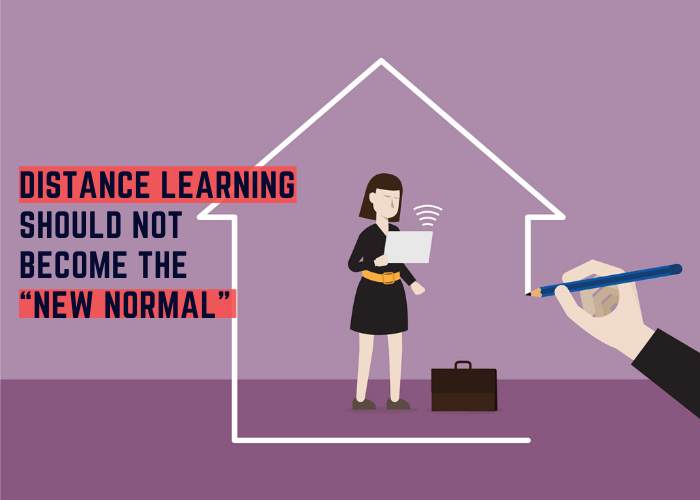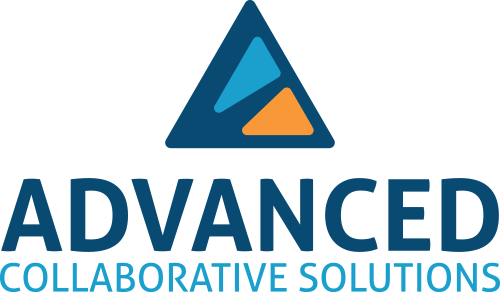Distance Learning Should Not Become the “New Normal”

By: Steve Ventura
Since we have been under “shelter-in-place” orders due to the COVID-19 crisis and schools have been forced to transition to distance teaching and learning, the phrase “new normal” has been applied to many different scenarios. But is this really what we want school to look like moving forward?
I want to make clear that I am not against using technology as a means of educating our children and I am not insinuating that we stop learning how to use and maximize technology. In fact, it is imperative that we continue to increase our ability to interact with students and their families by doubling down on communication and outreach. I am, however, deeply concerned about promoting virtual learning as the “new normal” over face-to-face learning opportunities, as these teaching and learning experiences can never be fully replicated remotely.
Distance learning was thrown onto schools, teachers, students, and families with little warning and became a “solution” when in-person school was just not possible, but that does not mean that it is or should be considered a best practice in education. Distance learning carries many significant barriers to equitable student achievement, effective teaching practice, and overall social and emotional health of students and teachers.
Distance or Virtual Learning is Inequitable
Equity has been a key issue since the pandemic started, with glaring examples of differences in learning between students who come from well-resourced families and financially secure districts and those who do not. Distance learning looks manageable for students with reliable internet access, dedicated devices, and parent support. But what about the students who have limited or no internet at home, have limited access to a device and may only include a parents’ smart phone that is often times shared with other siblings, have added stress with financial struggles in the family due to unemployment, and aren’t able to receive support from non-English speaking parents? These factors that often hold less of an impact when students are in a classroom, become huge barriers when distance learning is at play. Students with special needs have also been hit hard as research has shown for years that some at-risk students may still be more likely to struggle in an online environment that in a traditional learning environment (Means 2010). In addition, many schools have struggled to provide adequate services for students with special needs, regardless of federal guidelines. So much so that one teacher’s union in Chicago is suing Chicago Public Schools and the U.S. Secretary of Education, Betsy DeVos, for failing to provide adequate guidelines on how to support students with special needs.
One major question remains as distance learning looks vastly different from one student to the next—how can all students be supported equitably from a distance, and is it morally sound and ethical to serve students with more access while millions of students don’t have the tools to access virtual learning?
Educators Have Not Been Equipped to Teach Remotely
It’s quite clear that distance or virtual learning has been a source of stress, confusion, frustration, and anxiety for both teachers and students. Adapting to distance learning has not been easy by any means as it has required a significant amount of time and energy from all involved. Teachers are to be commended for rising to the occasion and creating learning opportunities, but often times the reality of not having clarity around student engagement and the learning that has occurred has teachers tossing and turning in their sleep. Moreover, teachers have had to develop new curriculum, further develop their instructional technology skills, support struggling parents and colleagues, all while trying to take care of their own families.
Instruction itself has been a mixed bag of strategies, including the idea of teaching new content or providing enrichment and review. Many educators feel that students should not be held responsible for new learning while others feel that not introducing new material promote further learning loss. Not only is instruction varied, but the challenge or rigor has lacked for many students.
Teachers are exhausted, and many contemplate if they will return in the fall. In a recent USA Today poll, one in five teachers say they are unlikely to go back to school if their classrooms reopen in the fall. The reason—83% say they are having a harder time doing their job. Two-thirds of responders say they have had to work more than usual and that they haven't been able to do their job properly since starting to teach remotely due to lack of support from the district.
Students and Teachers Need Human Connection
Not only are teachers feeling burnt out and tired, they are feeling a lack of direction and missing the bonds they have with colleagues and students. Teachers aren’t the only ones suffering from this lack of human connection. Learning is social, meaning that students thrive in situations where they can participate in reciprocal teaching, peer learning, and social cognitive learning. In districts around the country, leaders are turning the focus to social and emotional support, mental health, and mindfulness as students and educators alike struggle with this “new normal.”
Virtual Learning Works, But Does it Work Better?
Of course, there are advantages to virtual learning as well, but those advantages come after careful planning and implementation. Because of the current unanticipated circumstances, many virtual learning strategies were merely implemented as a way to keep kids in the education game, a fete worthy of note. In a matter of hours and days, schools and districts had to plan and teach simultaneously, which is not optimal and not what research suggests.
Virtual learning can work for those students on independent study, home hospital, and one-on-one learning. This is not to imply that its use is limited to these three groups of learners. However, there is one constant variable—all of these programs include varying degrees of blended learning, meaning that none of them are strictly virtual. They maintain a balance between distance learning and face-to-face encounters, enabling teachers to further personalize lessons that address individual student needs.
But Wait, Emerging Discoveries through Virtual Learning
Even with its complications, virtual learning has revealed some interesting truths, especially in these last few weeks.
1. Feedback replaces traditional grades. Grading is one of the most emotional topics in all of education, as it seems nearly impossible to create the perfect grading scale. But grades have taken a back seat in the last few months which provide additional opportunities for students to receive feedback that is accurate, fair, and timely.
2. Mechanical grading practices vanish. Virtual learning has teachers depending less on mechanical grading practices, like averaging, using the 100-point scale, and assigning “zeroes.”
3. The equity divide with homework becomes more visible. Homework has always been an equity issue, but virtual learning has exposed this even more, as teachers are discovering the meaning of “essential workers." Not everything is equal when schools ask students to complete work at home, and this is more visible than ever to school leaders and teachers.
4. Teacher clarity has become a focus. Learning intentions and success criteria must be clearly articulated, shared with students, and referred to often in order to promote the advantages of teacher clarity. From a distance, teachers have focused on providing clarity for learning to support families and students.
5. Teachers have received high praise for adapting. Parents and families have a new found appreciation for teachers, since they have had to provide the adult supervision required for learning, especially for younger students and those with special needs. Let's hope this appreciation continues no matter the learning environment.
Lessons Learned and Where Do We Go Next?
Since instruction and planning have changed in order to respond to distance learning, a few positives have emerged. All of us have had to become better consumers of technology and we are learning how to apply new applications and platforms. As weeks of virtual learning turned into months, many educators learned how to provide balance between teaching new material and opportunities for reteaching. Many teachers have focused on open-ended assignments that were designed to give students suitable time to work at their own pace. And the academic death penalty for late or missing work has been replaced by giving students multiple opportunities to demonstrate proficiency.
There also seems to be a heightened awareness of professional and personal relationships and support among teachers as communities have formed over social media and other online networks of educators sharing tools, resources, and stories. Teaching is social and teachers have found ways to embrace this from a distance.
In a recent article, my friend and mentor, John Hattie, wrote, “We have a chance to truly make a difference to the quality, the teaching, the learning, the outcomes of schooling by using this unexpected ‘experiment’ to bring a ‘new normal’ of teaching and learning.” As many districts around the country think about the fall school year and contemplate whether they will reopen for in-person instruction, continue remote learning, or find a hybrid of the two, I hope that there is a focus on what has not worked, what has worked best for student achievement, and how to make school equitable for all students, especially from a distance.
References
Hattie, John. “The New Normal of Learning: Build Back Better,” Corwin-Connect (blog), May 22, 2020, https://corwin-connect.com/2020/05/the-new-normal-of-learning-build-back-better/.
Means, B. et al., “Evaluation of Evidence‐Based Practices in Online Learning: A Meta‐Analysis and Review of Online Learning Studies.” U.S. Department of Education, September 2010. p. xvi.
https://www2.ed.gov/rschstat/eval/tech/evidence-based-practices/finalreport.pdf (accessed May 28, 2020).
Page, Susan. “Back to School? 1 in 5 Teachers are Unlikely to return to Reopened Classrooms this Fall, Poll Says.” USA Today, May 26, 2020. https://www.usatoday.com/story/news/education/2020/05/26/coronavirus-schools-teachers-poll-ipsos-parents-fall-online/5254729002/ (accessed May 28, 2020).

